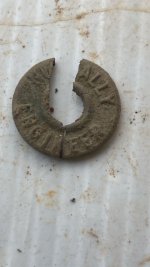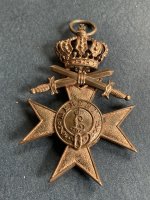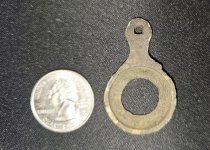Alright i'm posting here to hopefully get a little insight or direction to where im currently at in my metal detecting. Any advice is very much appreciated.
My and a friend have gotten really involved in metal detecting/treasure hunting in the past year. Our tools now include a Garrett AT Gold, Whites Coinmaster Pro, 2 whites Bullseye II Pinpointers, and specialty shovels.
I live on a property that i grew up on and have about 200 acres of land (in South Carolina) that my father owns. On this land used to stand the house that i grew up in. This is why i got so interested in all of this. My home was built in 1835 and burned down in 2009. It was a very sad day to see that house go up in flames here are a few images of that.
here are a few images of that.




Well, i actually did the cleanup of the house with my backhoe and tractor and a dug a HUGE hole and buried it off the back yard. Had i been more into it at the time i would have taken more time to sift through everything. But I did not take much time to do that. I basically just got the job done.
Well I just want to see if anyone can offer any kind of tips or pointers or if anything stands out anyone that might spark something or somewhere to dig.
When I first started the cleanup i KNEW something had to be under those chimneys. And, i was right. under the chimney pictured below, all the way under the foundation stones on the left i found a old leather pouch with 2 confederate bills and some old coins (also pictured below)


Well to say the least i got very excited about doing more digging. But really didnt start until a year ago getting heavy into it.
Here is the house after the cleanup



So i have this old plantation home and so many places to dig. Me and my friend have spent quite a few hours and have found not too much that have been worth finding. We have found probably 50 pennies (5 of them wheat), a buffalo nickel and an indian head penny. We have also found other things but not really valuable. I will post pictures of some of those finds in post 3
Well one thing i started out doing since i had a backhoe at my disposal was digging trenches and digging from the side instead of from the top. This was before i had the metal detector. I ended up finding a few trash piles but nothing of value. Is there any good to doing it this way? or is it just wasted time? here are some pics of how i was doing it



There was a story of one of the previous owners burying money around the property. that is what im looking for!
I even went to the courthouse to try and trace back the original owner and how it got passed down. I was actually successful in finding who built the house and every owner since then.
Alfred Scarborough built the house in 1835
*Not sure of the activity between these 2*
LL Baker purchased in 1919 and sold the following month to EH Hearon
Then is seems the Bank took? is from him and RH Hudson purchased it in 1936
In 1971 John Herndon purchased it and he was actually the father of Mark Herndon which is the drummer for county group Alabama
Then finally my father purchased it in 1978
I tell you all that just to give an idea how the home came about over the years. It was a large plantation home and thats why i believe there has to be some treasures out there somewhere.
There is also a church down the road that Alfred Scarborough gave the land to. It was built in 183?. I even got permission to search there but it came up VERY short. found one wheat penny and about 20 budwieser cans. I couldn't believe so many beer cans on church property. Did not have much luck at all like i thought we would
So im going to post some pics before the fire just to see if anyone has any suggestions on where i could maybe search for something new. i feel like im hitting a wall. We have scoured that property for the most part and just want to see what we should do next.
One bad thing that right where the house stood there is a ton of melted metal and things. So metal detecting there is very hard. We keep finding the clomps of metal that register high on our detectors.
Places i have searched pretty well is the front yard and around old trees
I will post pics of the house before fire in the next post
Any advice is greatly appreciated! I will continue to use this forum in the future.
My and a friend have gotten really involved in metal detecting/treasure hunting in the past year. Our tools now include a Garrett AT Gold, Whites Coinmaster Pro, 2 whites Bullseye II Pinpointers, and specialty shovels.
I live on a property that i grew up on and have about 200 acres of land (in South Carolina) that my father owns. On this land used to stand the house that i grew up in. This is why i got so interested in all of this. My home was built in 1835 and burned down in 2009. It was a very sad day to see that house go up in flames
 here are a few images of that.
here are a few images of that.Well, i actually did the cleanup of the house with my backhoe and tractor and a dug a HUGE hole and buried it off the back yard. Had i been more into it at the time i would have taken more time to sift through everything. But I did not take much time to do that. I basically just got the job done.
Well I just want to see if anyone can offer any kind of tips or pointers or if anything stands out anyone that might spark something or somewhere to dig.
When I first started the cleanup i KNEW something had to be under those chimneys. And, i was right. under the chimney pictured below, all the way under the foundation stones on the left i found a old leather pouch with 2 confederate bills and some old coins (also pictured below)

Well to say the least i got very excited about doing more digging. But really didnt start until a year ago getting heavy into it.
Here is the house after the cleanup
So i have this old plantation home and so many places to dig. Me and my friend have spent quite a few hours and have found not too much that have been worth finding. We have found probably 50 pennies (5 of them wheat), a buffalo nickel and an indian head penny. We have also found other things but not really valuable. I will post pictures of some of those finds in post 3
Well one thing i started out doing since i had a backhoe at my disposal was digging trenches and digging from the side instead of from the top. This was before i had the metal detector. I ended up finding a few trash piles but nothing of value. Is there any good to doing it this way? or is it just wasted time? here are some pics of how i was doing it



There was a story of one of the previous owners burying money around the property. that is what im looking for!

I even went to the courthouse to try and trace back the original owner and how it got passed down. I was actually successful in finding who built the house and every owner since then.
Alfred Scarborough built the house in 1835
*Not sure of the activity between these 2*
LL Baker purchased in 1919 and sold the following month to EH Hearon
Then is seems the Bank took? is from him and RH Hudson purchased it in 1936
In 1971 John Herndon purchased it and he was actually the father of Mark Herndon which is the drummer for county group Alabama
Then finally my father purchased it in 1978
I tell you all that just to give an idea how the home came about over the years. It was a large plantation home and thats why i believe there has to be some treasures out there somewhere.
There is also a church down the road that Alfred Scarborough gave the land to. It was built in 183?. I even got permission to search there but it came up VERY short. found one wheat penny and about 20 budwieser cans. I couldn't believe so many beer cans on church property. Did not have much luck at all like i thought we would

So im going to post some pics before the fire just to see if anyone has any suggestions on where i could maybe search for something new. i feel like im hitting a wall. We have scoured that property for the most part and just want to see what we should do next.
One bad thing that right where the house stood there is a ton of melted metal and things. So metal detecting there is very hard. We keep finding the clomps of metal that register high on our detectors.
Places i have searched pretty well is the front yard and around old trees
I will post pics of the house before fire in the next post
Any advice is greatly appreciated! I will continue to use this forum in the future.
Last edited:


















